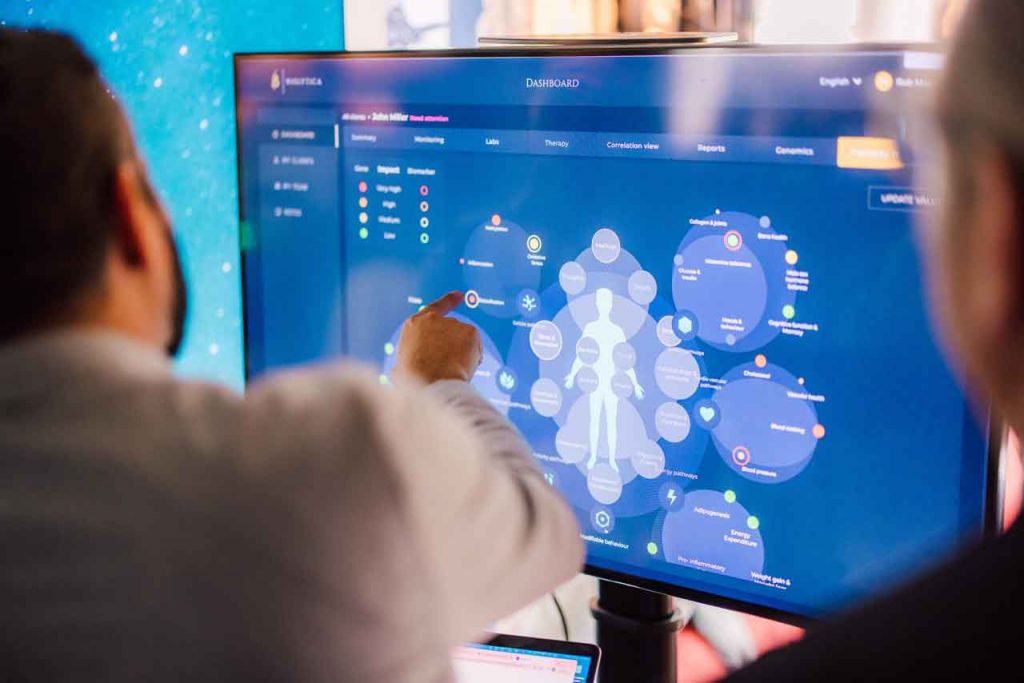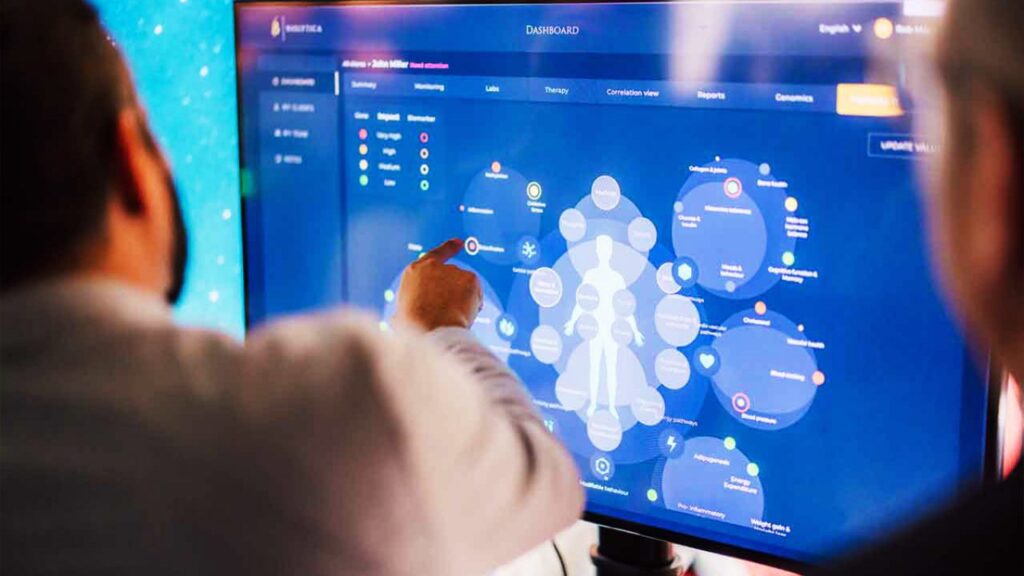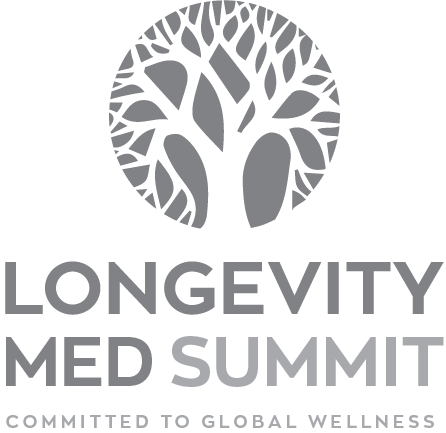All Biometric data in one AI platform for longevity
All Biometric data in one AI platform for longevity
The Swiss start-up Biolytica has launched a longevity health data platform, giving healthcare and longevity professionals a tool to help them optimise personalised and preventive health plans for clients and patients. The Biolytica NEXUS platform brings together data from multiple sources – genomics, pharmacogenomics, epigenetics, biomarkers, wearable-devices, lifestyle, nutrition, and many others – using AI analysis to deliver unique healthspan and longevity insights.
The driving principle at the core of Biolytica is the unification and analysis of the growing amounts of health data that are now being collected across a wide range of health areas.
“We have so much data available to us: genomics and pharmacogenomics; epigenetics; all the labs, biomarkers, microbiota,” says Dr. Rob Konrad. “We have new aging clocks, data from wearable devices that everyone is wearing, personal historical health data, and everything else. All of this should allow us to deliver more personalised, preventive healthcare, and recommend longevity related interventions.”
Getting health data out of silos
However, all this great data is rarely put together in a way that can be easily used by clinicians to benefit their patients and clients.
“Health data is typically stuck in silos,” explains Konrad. “And it’s hard to get that data out of the silos and combine it in a useful way. So that’s what we’re doing at Biolytica – we’ve built our NEXUS platform, which breaks these silos and brings all this data together in a single, unified platform.”
Rather than try to offer the platform and its analytics directly to consumers, Biolytica is targeting longevity and healthcare professionals. Initially at least.
“This is a tool for longevity clinics, treatment centres or longevity health coaches to help them make more sense of the data,” says Konrad. “But in the future, our goal is definitely to give more people access to this.”
While the concept of bringing all this data together may sound like a straightforward enough idea, Konrad says that the reality is far from simple. The first big challenge the company faced was largely technical.
“We first had to create something that’s able to ingest, store, process and audit all these data points,” says Konrad. “Because health data ranges from very structured data from labs or genomics tests, which is relatively simple to process, through to the nightmarish area where you have the scribbled notes from your doctor sitting in a physical file. We wanted to build something that can really process, correlate and analyse all of that, agnostic of the source it’s coming from.”
Visualising health data differently
At the heart of the Biolytica NEXUS platform is a dashboard view of a person, which provides a unified view of all their different health data points. The data on NEXUS is visualised in a clear and simple way, with colour coding and other visual cues used to identify areas that may require attention.
“If you see something in red, then there’s probably something that you need to start thinking about, if you’re in the green, then you’re probably doing something right,” says Konrad. “It makes it easier to understand what’s going on. Our clinical team is also helping us to give the platform a level of intelligence. We can use the data, for example, to create aging clocks and simplified health reports.”
What a healthcare professional sees on a patient’s dashboard, however, is entirely configurable to their needs.
“If you don’t need genomics or epigenetics or medical reports, for example, you can just remove these parts,” says Konrad. “The platform is completely flexible. It’s not meant to change the way you work – it’s meant to support you in your work by making sense of the data that you have. We want to help clinicians move away from looking at printed reports and PDFs – to help them see everything in one place.”
While initially offering a simplified view, any of the areas included in the dashboard can also be expanded to provide access to all the available data, allowing clinicians to “drill down” into the detail. But NEXUS really comes into its own when it starts making connections between different data points.
“We have many different pathways in our body – cellular pathways, systems pathways, cardiovascular pathways, and so on – and we have a lot of information about these in our genetic blueprint,” says Konrad. “Not only can we look at these genetic reports in great detail, but what you can also see on the dashboard is when there are any high-impact genes that should be looked at, and then combine with the information about the current health status that we get from biomarkers and wearables.”

Combining key data points
If a person with a genetic predisposition for a certain condition receives relevant data, from a wearable device, epigenetics or blood test, for example, NEXUS will display that data on the dashboard as a dot with a circle around it. If both are red, then it indicates high genetic impact combines with an adverse biomarker result.
“Whenever you see this ‘target’ you know that here is a genetic predisposition for something combined with a biomarker that tells you that things may not be right – the genes are expressing in some way,” says Konrad. “Longevity is all about prevention and precision, and we want to help clinicians optimise their patients and clients towards certain endpoints. What are the modifiable risk behaviours you can start working on in your body? There are lots of things going on in our bodies all the time, and there are always lots of things we can optimise, whether through lifestyle, diet, supplements or molecules.”
Another unique feature of NEXUS is its “correlation view”, which allows clinicians to assess the impact of longevity interventions.
“You can overlay any biomarker against any intervention,” says Konrad. “If you’re starting to take a supplement, you usually want to have a result, whether you want your blood pressure to drop or your lipids to improve. With this tool you can see everything in correlation – you can really start to if interventions are having the desired impact.”
“One of the criticisms that that I have for the longevity industry is that people are making interventions blindly, without tracking themselves, without taking baselines, without thinking of possible negative interactions between drugs and/or supplements, and so on. If we all bring all the data together, we can start seeing the patterns. We can show what works, what doesn’t work, and how it works. I believe what we’re building here is a platform that can help the whole longevity industry to track changes better and become more scientifically and medically relevant.”
Predictive interventions in future
To ensure the company did things properly, it has assembled an experienced development team, bringing in ex-Novartis, Pfizer,and Merck development and data experts, some of them with more than 25 years’ experience in health data management.
“We first worked on how to visualise the data, bring it together and give it some initial logic,” says Konrad. “And that leads us up to where we are today, which is using aggregated data on the platform, in an anonymized way, to find patterns, create advanced analytics, and build algorithms that can make better predictions about peoples’ health trajectory.”
In its current form, the NEXUS platform supports the practice of longevity medicine, by providing data that clinicians can analyse and then make informed recommendations and suggestions. But Konrad explains that the future of the platform is much more than that.
“We believe a lot of health recommendations can be and should be automated,” he says. “Because a lot of the conclusions that these brilliant clinicians draw are essentially one plus one equals something. However, we need to make sure that any recommendations we make are strictly scientifically and medically driven. We believe through better data analytics we will get to a point where we can really make good predictive interventions happen. This will also help many more people to have access to longevity medicine, which is only accessible to a select few at this point.”
While NEXUS is a tool that is being developed in the context of longevity, Konrad says that it has applications in many different areas.
“We’re talking to lots of different verticals,” he says. “A cancer centre in Switzerland, for example, said that having this detailed view on data would be amazing because they test people all the time during the course of their chemo treatment and therefore need to look at labs all the time, so just visualising things differently could help them greatly by having everything in one place.”



